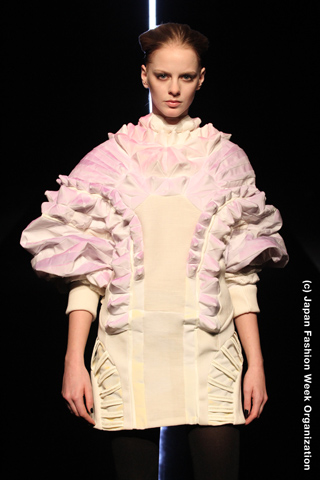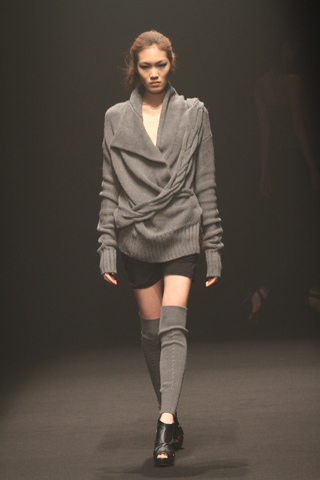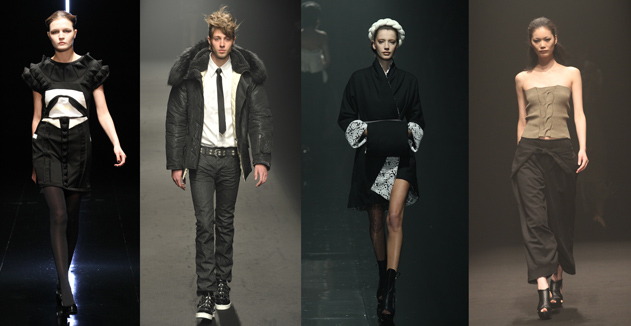It’s that time of year again—Japan Fashion Week has come to Tokyo. Because of the public holiday on March 22, most of the shows and events were squeezed into just four days this season. Read on for a recap of the first two days…
Entopic
 A newcomer to Japan Fashion Week, Entopic kicked off the festivities with the first show on Tuesday morning. Designers Wataru Matsumoto and Kenta Kakinuma showed a nearly all-black and grey collection of leggings and skinny pants paired with more voluminous tops, sweaters and jackets. Ribbons of fabric wrapping around the ankles and patches of contrasting textiles elevated the leggings to a bit more than basics, and a series of tops with cutouts and woven strips of fabric added interest. The show closed with its only white piece—a minidress with fabrics folded like origami fabrics that gleamed in the black light.
A newcomer to Japan Fashion Week, Entopic kicked off the festivities with the first show on Tuesday morning. Designers Wataru Matsumoto and Kenta Kakinuma showed a nearly all-black and grey collection of leggings and skinny pants paired with more voluminous tops, sweaters and jackets. Ribbons of fabric wrapping around the ankles and patches of contrasting textiles elevated the leggings to a bit more than basics, and a series of tops with cutouts and woven strips of fabric added interest. The show closed with its only white piece—a minidress with fabrics folded like origami fabrics that gleamed in the black light.
@Izreel
Kazuhiro Takakura also favored black for one of the week’s few men’s-only brands. Models walked the runway to loud, thumping music in tight pants, cargo shorts, fur-trimmed vests and jackets, and varsity letter sweaters. Large houndstooth motifs featured heavily on suits, while leopard prints graced two jackets, one of which was a velour blazer.
Satoru Matsuda
For this year’s fall/winter season, Satoru Matsuda dressed his models in elegant yet modern pieces, often with an asymmetrical twist. The colors were a muted mix of browns, greys, reds, beiges and black, and textures ranged from delicate chiffon to chunky knits. Like many other of the week’s designers, he also worked in bits of fur, which were seen mostly on jacket collars and as mufflers.
 Araisara
Araisara
Designer Sara Arai, who spent much of her life in China, once again called upon Asian influences for her fall/winter collection. Colors were deep and saturated, including wine red, mustard, teal, and purple, and were often used in soft, watercolor-like prints. Arai made use of the delicate, flowing fabrics and intricate construction for which she has become known to create asymmetrical blouses, billowing dresses, and even a floor-sweeping cape. A small series of all-white pieces also stood out, particularly a coat that revealed a black lace lining when held open by model Ai Tominaga.
The Dress & Co. Hideaki Sakaguchi
Nautical themes are an old standby for spring and summer collections, but Hideaki Sakaguchi managed to make the marine look seem fresh by pairing it with wool, tweed and fur for fall. Silk scarves in navy, white and gold were seen tucked into shirts, draped over shoulders, and wrapped around models’ waists. Sakaguchi mixed his preppy pieces with feminine dresses fashioned from lace, eyelet and velvet, and even included quirky footless tights printed with
a motif of lace stockings and garter belts.
Jotaro Saito
Japan’s cult favorite kimono designer showed to a packed house on Tuesday night, where several audience members were dressed in immaculate kimono, including one geisha in the front row. Saito is perhaps the most well-known modern kimono designer, incorporating geometric, floral, textured, and patchwork-like patterns into these traditional Japanese garments. Other contemporary twists included a bold use of color and metallic threads, and the music to which the models glided down the runway: a surprising mix of hip-hop, techno and classic rock.
Check the next issue of Weekender (out April 16) for coverage on the last two days of autumn/winter 2010 Japan Fashion Week.
Photo credits: Photos courtesy of Japan Fashion Week Organization
Jotaro Saito photos by Kelly Wetherille
External Link:
Japan Fashion Week









